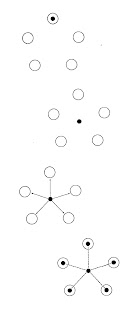 A coach's white board detailing an in-bound play with 12" left on the clock? Snow flakes on a grade four window display? Cell division in cheese bacterium too long left on the counter top? A sociogram modeling growth of adolescent communication patterns? (Well maybe the latter two are about the same thing.)
A coach's white board detailing an in-bound play with 12" left on the clock? Snow flakes on a grade four window display? Cell division in cheese bacterium too long left on the counter top? A sociogram modeling growth of adolescent communication patterns? (Well maybe the latter two are about the same thing.)
A number of conversations in the past week would point to the cute little doodle at the left representing the hoped-for evolution of self-awareness as we engage a regular mindfulness practice.
Conversation one surfaced with the guilty confession that a whole week had been consumed reading fiction -- the equivalent of 'skimming while Rome sizzled'. In short, getting lost in several good books, as it turns out, to avoid a direct look at more urgent material -- 'happily' pushed into the periphery. Conversation two, a little less explicit, made its point through some subtle, critical self-references, in an otherwise confident, self-assured individual -- begging the question of 'where'd that come from?' And conversation three -- this from a new meditative practitioner -- commenting on the conflicted presence of an improved memory and increased emotional distress. Pretty diverse data!
What element all three seemed to share was that of a working consciousness that excluded, wholly or in part, perhaps less desirable or even feared aspects of a more complete self. In short, operating from a compartmentalized, truncated, or circumscribed self. Back to the doodle for a moment. The schematic is borrowed from a writer on psychosynthesis, an approach to personal psychology that, like Jung and other turn of the century theorists, advocated a 'full consciousness' as the healthiest (least neurotic, in Jung's terms) approach to psychological maturity and function.
The four 'little snowflakes' represent different stages of consciousness or awareness in a given individual. The black dot identifies those elements of self of which the individual is aware and engages regularly; the small circles, various aspects or 'sub-personalities' within the individual; and the lines (or absence thereof) reflecting the degree to which the individual is aware of these aspects. No line or connection = no awareness; a dotted line, partial or sporadic awareness; a solid line, full awareness. In the top diagram, we have a relatively common circumstance where a person essentially 'places all their ego eggs in one basket'. They are fully conscious of only a small part of their complete personality and are evidently quite content to live and operate in this little corner of their world. The downside of this arrangement is that, sooner or later, these other 'shadow aspects' will make their presence known; often with, because these are relatively 'foreign' to the individual, chaotic and disturbing results.
Diagram two is a slight improvement and perhaps the commonest circumstance of all. In this situation the individual has a reasonably 'balanced' ego -- but precarious, as he/she is still quite in the dark regarding all those 'relatives' lurking in the shadows; no lines between the ego/active consciousness and sub-personalities. Conversation one is an example of this: blinders in place, avoidant practices fully engaged -- all with the aim of keeping at bay vague, disturbing, or openly feared issues. An excellent recipe for anxiety.
With schematic three we're getting somewhere. A 'balanced', centrally positioned ego and an awareness of the 'siblings in the wings'. But not quite there just yet. Awareness is not acceptance or engagement. Conversation two is an example. Here the individual 'names' an aspect of self -- but in pejorative terms, suggesting shame and embarrassment around, rejection of that aspect. The 'step-sister' is acknowledged -- but sent to the woodshed. Equally conversation three has elements of this mode of function. With a newly minted mindfulness practice, he/she has moved from 'stage one', wherein avoidance of issues had (of necessity in earlier times) been so 'successful' that it bled through to interfere with attention to (and consequently memory for) just about anything that smacked of disturbing material; to stage three where, urged to 'sit with' (vs. shut out) such material, the individual had become more conscious of it, and less reactive to it -- but continues to be disturbed by its presence.
Finally, diagram four. Here we have an individual fully aware of and participating in all aspects of self. The ego is 'spread around', engaging all sub-personalities -- whether sunny or dark, socially facilitative or suspect. This individual is unlikely to be blind-sided or anxious; is likely to present as authentic in relationship; and might be seen as someone who fully knows and accepts themselves. Part of the 'Who Am I' meditation practice is an important and courageous step toward this type of awareness. Kind of the equivalent of passing the ball to all our personal 'players' at once -- imagine how effective that would be when you've only got 12" to make that basket!
No comments:
Post a Comment